The importance of employee engagement is hardly ever questioned. According to recent employee engagement statistics, a highly engaged workforce can lead to 23% greater profitability, a 14% increase in overall productivity, an 18% rise in productive sales, 81% lower absenteeism rates, and a 66% improvement in employee well-being.
That said, knowing how to measure engagement effectively can be challenging. Developing the right employee engagement action plan relies on several factors: your specific goals, your organization’s characteristics, and even the personality traits of your employees.
In this article, we’ll detail how to create an employee engagement measurement strategy and highlight the key considerations for achieving success.
Looking to simplify your employee engagement management with tech? You may want to check out our roundup of the best employee engagement software.

Step 1: Define Employee Engagement Success
As soon as they think about measuring employee engagement, many companies come up with a survey, get employees to fill it out, and then shelve it. They might get stuck because they don’t know what to do next, and they don’t know because they never defined what they hoped to achieve from the survey.
Of course, there are many other ways to measure how engaged your workers are apart from a survey, but the same pitfall can hold true for all of them.
So, before you design an employee engagement strategy, first define the impact you expect from the initiative. It’s like telling a story by stating the ending and then explaining how it got there from the beginning.
What Is Employee Engagement for Us?
To define this expected impact, create a clear picture of employee engagement at the organization. Coursera defines employee engagement as “the emotional commitment and involvement an employee has toward their organization and its goals.”
Does this definition ring true for you? If so, what does that emotional commitment look like? What do your employees look and act like at their most engaged? Of course, this varies a lot depending on your industry and type of business, but it could be the level of absenteeism, whether people show up on time to meetings, whether people tend to take on more responsibilities than they’re required, if they show initiative and propose new projects or ideas, etc.
To start shaping this, you can think of desired outcomes when designing a tool like a pulse survey. These desired outcomes can be phrases, usually answers to open-ended questions, that help you gain insight into how engaged a person is with the organization, which can also be used for the actual surveys or interviews. For example:
- “I feel comfortable voicing my opinions and sharing my ideas.”
- “Our company culture resonates with who I am.”
- “The organization’s mission is compatible with my goals as a person”.
- “I’d recommend this company to a friend or family member.”
These are just examples that can serve to get you started. In order to find the outcomes that will work for you, let’s move on to step 2:
Step 2: Identify What Your Employees Care About
Through an initial survey and 1:1 conversations, you can learn what engagement means to each team member and discover the key topics that will form your definition of engagement.
These topics or themes could be work-life balance, organizational culture, talent development strategies, value and recognition, motivation, productivity, trust in leadership and colleagues, etc.

Once you have a set of topics that define engagement at your organization, the next is to determine what to measure within them. Are you going to measure them individually? Company-wide? Or perhaps across groups and teams? Also, look at vertical and horizontal relationships.
Pitfall Alert: Looking at Employee Engagement Solely on an Individual or Group Basis
A thing to avoid is to look at employee engagement only at the individual level since a lot of it can boil down to personality. Research from the Journal of Organizational Behavior suggested that their character traits largely determine the degree to which people become engaged with their jobs.
In a nutshell, personality traits like optimism and extroversion could account for almost 50% of an employee’s work engagement variability. This means that high engagement at the individual level is not necessarily an indicator of a healthy workplace since proactive extroverts, for instance, are much more likely to be resilient to toxic management or cultural issues.
On the flip side, creative individuals tend to be more cynical, skeptical, and hard to please than others. While this might not be great news for your group engagement levels, it may be where the best employee feedback comes from—the type of feedback that lets you identify cultural issues or questionable leadership styles and do something to fix them.
Hence, assessing employee engagement solely on an individual or group level is tricky. A comprehensive strategy should consider both developing an accurate and reliable company-wide view of the employee experience and avoiding performance bias.
Step 3: Choose Your Methods
You can measure employee engagement through different methods, including surveys (employee engagement surveys, pulse surveys, lifecycle surveys), one-on-ones, tracking goals and KPIs, and analyzing employee performances.
- The Annual Employee Engagement Survey: While you may need to survey more often, this is one of the tried-and-tested methods of gauging employee engagement. The annual survey is good for providing a broader snapshot of how the workforce is feeling and then comparing that year by year.
- Pulse Surveys: These surveys, typically deployed in asynchronous work, should have fewer but more relevant questions. They also don’t have to be taken at a certain frequency as long as it’s more than once a year. That means you can alter them as you go, depending on what’s more important, which is almost like having an async conversation between management and employees.
- Lifecycle surveys: These surveys are done at the individual level at key stages of the employee journey. Companies typically perform them when the employee joins, when they’re about to exit, and somewhere in the middle, like after certain milestones in their progress. There are several types of these, like training feedback, exit interview questions, or onboarding surveys, all of which can give you a glimpse of a person’s engagement.
- 1:1 Meetings: Private talks with managers or key colleagues can be an excellent way to gauge an employee's engagement with their work. This is also where insights on qualitative data are gathered best.
- Goal Tracking: Naturally, an indicator of engagement is how people are doing with their OKRs and KPIs. However, this has to be studied carefully. Not hitting the marks often enough might signal problems that are deeper than individual engagement, but that is precisely why it’s worth looking into.
- People Analytics: These days, if you’re using software to perform and keep track of work and HR processes, you can pull significant data from that. The power of people analytics includes finding workforce data trends and understanding employee engagement on a deeper level. For instance, higher turnover from a certain department could signal an engagement problem not present in the rest of the company, so it should be addressed accordingly.
- Open Door Policy: Lastly, as much as technology, surveys, and scheduled meetings can help, simply having a psychologically safe working environment where employees feel comfortable reaching out and talking about their experience is paramount. Often, your main source of new ideas on how to improve employee engagement is the workers themselves, and that shouldn’t be tied solely to a formal process.
Of course, these are only the main methods for measuring the effectiveness of your employee engagement ideas. You could also consider a dedicated feedback channel, an ideas box, or certain times within town hall or smaller group meetings. The trick is to mix and match between them to get both quantitative and qualitative data for a more holistic view, stay alert for new programs, and even try your own. There’s no surefire method here, but what is sure is that you’ll need to think of KPIs, which is what we’ll cover in the next section.
A final word here, however, is that you shouldn’t rely solely on survey results to improve engagement. Also, when doing surveys, you can’t apply them to a sample population or focus groups within the company and expect that alone to be an accurate depiction of employee engagement. That’s why a combination of methods is so important.
Step 4: Determine Your KPIs
Unlike sales and production, it’s not that easy to measure the workforce’s level of engagement with quantitative data. However, with the right key performance indicators, you can get pretty close to producing measurable engagement scores.
Much like the employee engagement measurement methods above, your KPIs should be a reflection of your business and its particular needs, but here are some of the main ones to get you started:
- Absenteeism: Consistently not showing up without notice is a strong indicator of disengagement, as it suggests low motivation and little commitment to the job.

- Employee turnover: A high turnover rate reveals the organization’s ability to retain talent. If this rate decreases over time, it’s a good way to measure improvement in employee engagement.

- Time taken off: A healthy work-life balance is another indicator of employee engagement. While it may seem counterintuitive, the fact that people feel comfortable taking time off is a good sign of engaged employees. It means they aren’t overloaded and trust their colleagues to help out if they’re away. Recent job satisfaction statistics show that the ability to take time off work more than doubles the likelihood of work satisfaction.
- Employee Net Promoter Score (ENPS): This metric started as a way to measure customer satisfaction. It was then applied to employees as well. The idea is to find out how likely a person is to recommend working at the company to a friend. This can be answered on a scale from 0 to 10. Anyone answering 0 to 6 would be considered a detractor, 7-8 are considered passive, and 9-10 answers are considered promoters. Then, you apply the following formula:

- Internal Promotion Rate: How often do employees grow within the organization? This metric can also be an indicator of employee engagement and is usually measured as follows:

- Employee Satisfaction index: In a manner similar to the ENPS, this metric is calculated by having employees answer one or several questions on a scale of 1 to 10. The math is similar, but you have to use the outcomes we talked about in Step 1.
- Active Tool Usage: Through the software that your employees use, whether it’s messaging tools, an intranet, an employee portal within an HRMS, or an employee recognition platform, it’s likely that you can get stats on company-wide usage. You can look at how many active users there are for each tool, how often people log in, how quickly people adopt new software, etc.
- New Hire Failure Rate: A low score here should signal a healthy overall engagement. A substantial number of recently onboarded employees should stay on after their first three months. If the opposite is true, it’s an alarm for recruiting, onboarding, and workplace health.

Step 5: Find the Right Tool
Now that you likely have a better idea of what employee engagement means at your workplace and how you can measure it, it’s time to decide whether you need a special tool for this.
Smaller companies may do just fine by following a rudimentary approach and keeping everything on a spreadsheet. However, as your needs and headcount grow, it can quickly become too much to handle. As with many human resources processes, there is specialized software you can use to alleviate these tasks and automate or streamline what is just too time-consuming to do manually.
Employee engagement software features data collection through various forms, which allow HR and People Analytics teams to understand what’s happening with their company culture and put it into shareable insights that can drive decision-making.
This type of software also helps the employee experience since everything related to feedback efforts and, in some cases, even performance management can happen in the same place. It is also often social, mobile, smart, and connected to the tools your people already use (e.g., team collaboration tools or HRIS), making it much easier for them to get around answering that pulse survey or requesting feedback.
Building an Employee Engagement Framework
Measuring engagement becomes far more effective when it’s tied to a clear framework. It provides structure by clarifying what to observe, how to interpret data, and the next steps. Some notable employee engagement frameworks include the AON Hewitt, Gallup Q12, JD-R, Four Enablers, and Nienaber & Martins frameworks, which are often combined by organizations.
AON Hewitt Engagement Model: For Quick Pulse on Advocacy and Retention
AON Hewitt’s employee engagement model simplifies engagement into three behaviors that show how invested employees are in the organization. It’s a practical way to see whether people are simply satisfied or fully committed.
- Core Focus: Differentiating satisfaction from true engagement.
- Key Dimensions: Say (speak positively about the company), Stay (show commitment to remain), Strive (go above and beyond).
- Best Use Cases: Quick diagnostics to identify levels of employee commitment.
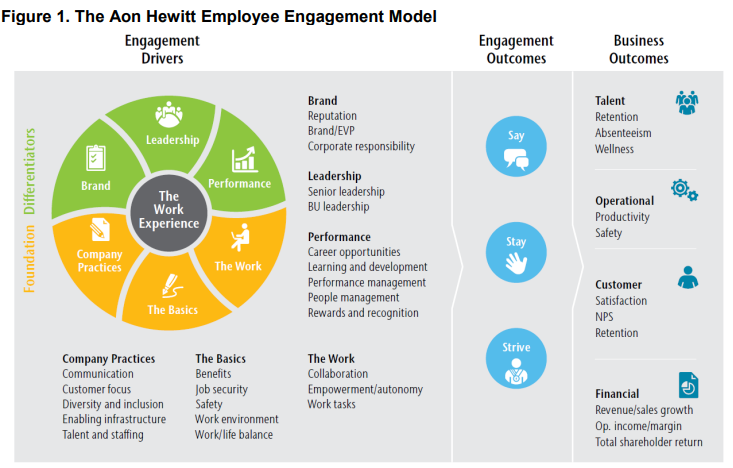
Gallup Q12 Model: For Benchmarking and Validated Survey Data
Gallup developed a set of 12 validated questions that highlight the workplace conditions most likely to drive engagement. These cover everything from clear expectations to recognition and career growth.
- Core Focus: Pinpointing conditions that foster engagement.
- Key Dimensions: Expectations, recognition, development opportunities, manager and peer relationships.
- Best Use Cases: Benchmarking against global standards and building survey-driven engagement programs.
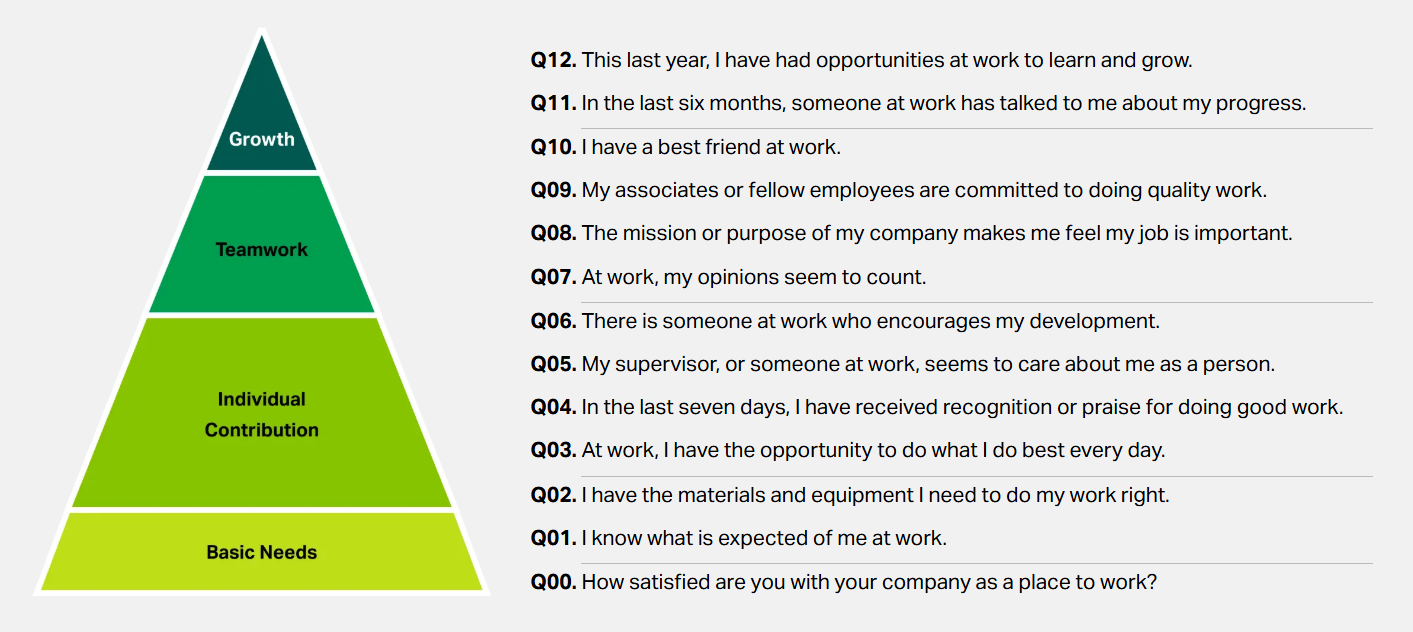
Job Demands-Resources (JD-R) Framework: For Balancing Workload and Resources
The JD-R framework looks at how the balance between job demands and available resources influences engagement. When demands outweigh resources, burnout is more likely; when resources are strong, engagement tends to grow.
- Core Focus: Balancing demands and resources to sustain engagement.
- Key Dimensions: Job demands (workload, stress, role conflict) vs. job resources (autonomy, support, learning opportunities).
- Best Use Cases: Understanding stress and burnout; designing healthier work environments.
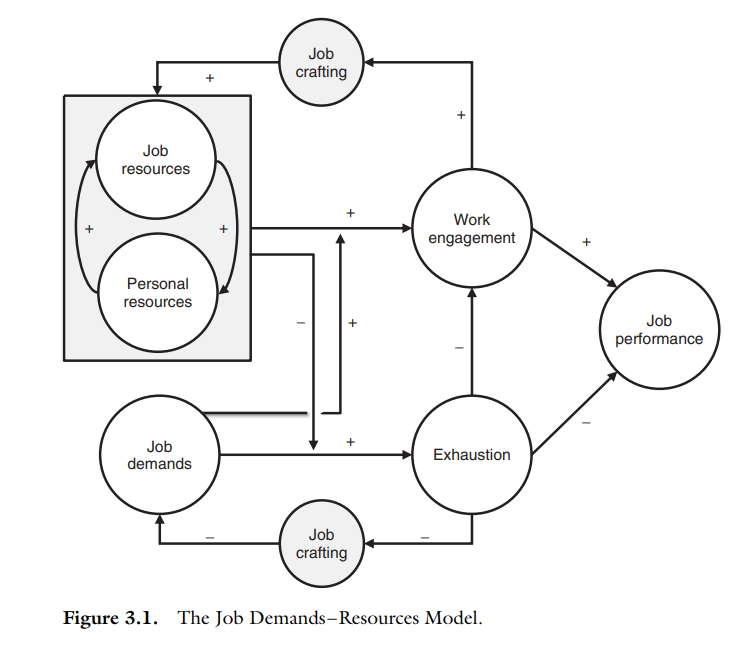
Four Enablers of Engagement (MacLeod & Clarke Report): For Focused Culture and Leadership
Commissioned in the UK, the four enablers of engagement framework highlights organizational levers that shape employee engagement. It’s highly practical for culture and leadership improvement.
- Core Focus: Organizational and cultural drivers of engagement.
- Key Dimensions: Strategic narrative, engaging managers, employee voice, organizational integrity.
- Best Use Cases: Culture transformation, leadership alignment, building trust.
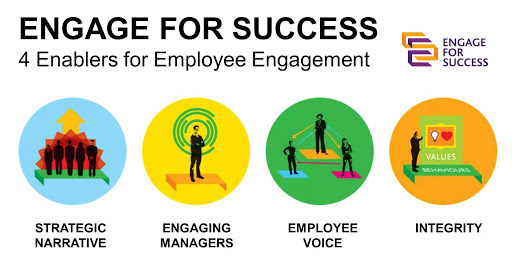
Nienaber & Martins Engagement Framework: For a Multi-Level, System-Wide View
Developed through academic research, this model integrates individual and organizational levels of engagement. It connects employee experience directly to organizational competitiveness.
- Core Focus: Holistic integration of individual and organizational engagement.
- Key Dimensions: Job design, leadership, HR policies, culture, work environment, team dynamics, and well-being.
- Best Use Cases: Comprehensive assessment linking engagement with organizational performance.
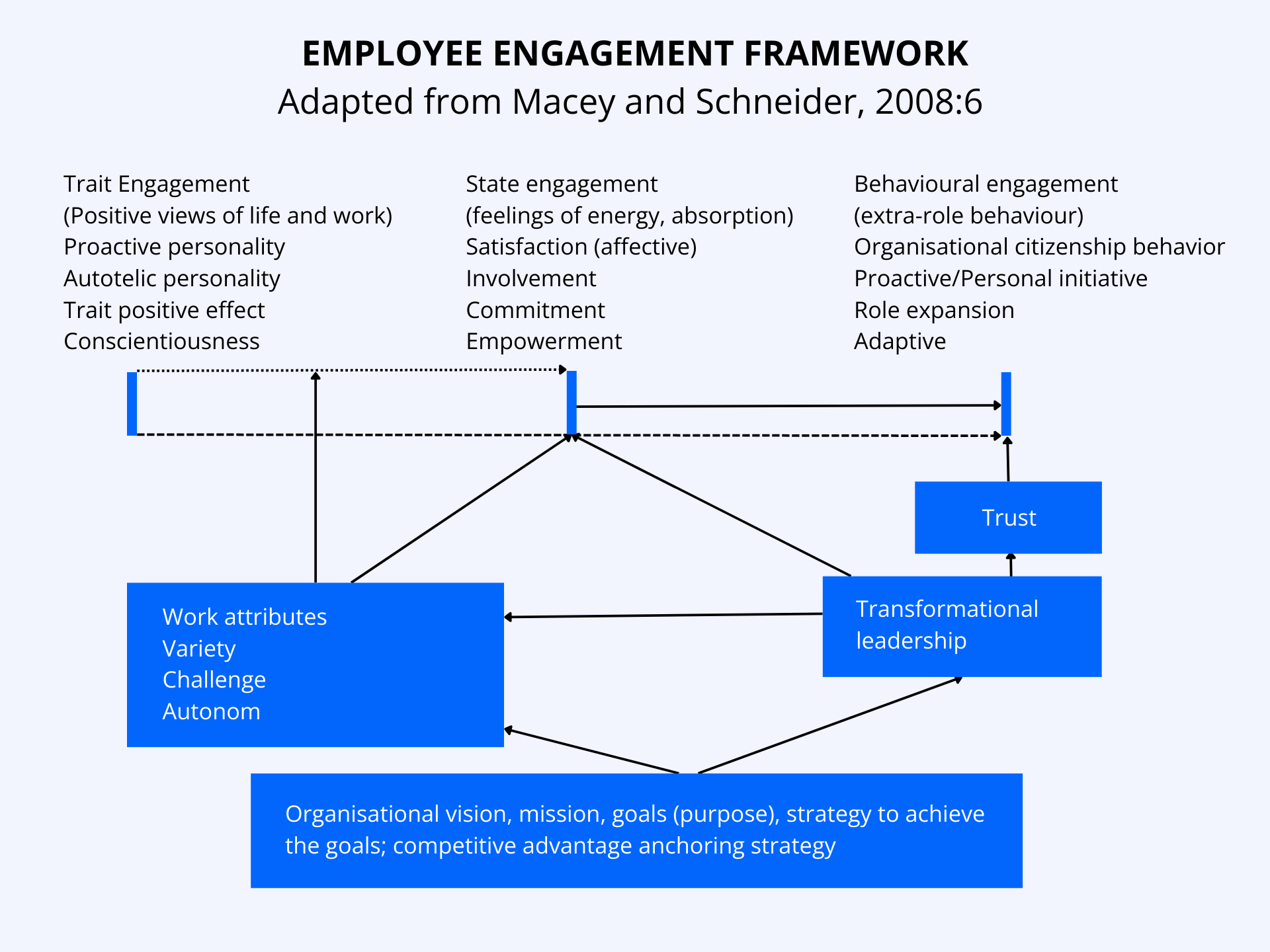
Employee Engagement Measurement FAQs
What is employee engagement?
Employee engagement refers to the emotional commitment and involvement an employee has toward their organization and its goals, resulting in higher motivation and productivity.
Why is it important to measure employee engagement?
Measuring engagement helps organizations identify areas for improving employee satisfaction, productivity, retention, and overall performance, which contributes to business success.
How do companies measure employee engagement?
Companies use tools like surveys, one-on-one interviews, focus groups, and pulse surveys to gather feedback on employee attitudes and experiences.
What do employee engagement surveys measure?
Engagement surveys measure factors like job satisfaction, alignment with company values, relationships with peers and leaders, recognition, and opportunities for growth.
How often should I measure employee engagement?
An annual comprehensive survey provides crucial baseline insights, while quarterly pulse surveys enable organizations to monitor shifts and address issues proactively. So ideally, using both would result in higher retention rates and a more committed team.
What is employee engagement software?
Employee engagement software is a tool that helps organizations measure and improve employee satisfaction, motivation, and productivity through feedback, recognition, and communication.
Key features of an employee engagement platform include:
- Engagement survey and feedback gathering.
- Insights into engagement trends with dashboards and reports.
- Peer-to-peer recognition and reward systems.
- Pulse surveys for frequent engagement tracking.
- Integrations with HR tools such as HRIS/HMRS/HCM, OKR platforms, and employee performance systems.
- Tools for employee mental health and well-being support.
























